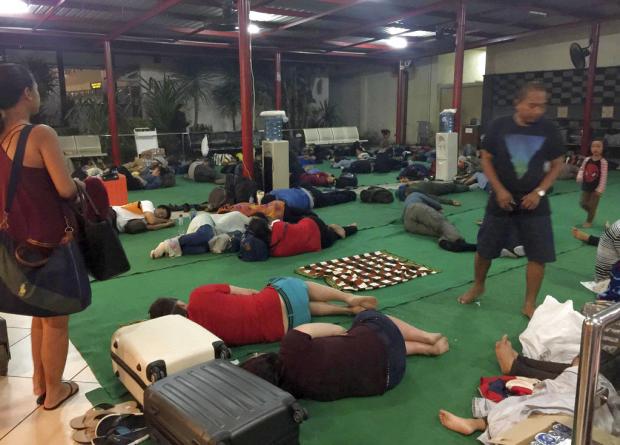Bali airport reopens, but volcano still spewing ash

Tourists sleep at the airport in Surabaya, Indonesia, after leaving the island of Bali by ferry following the cancellation of their flights due to smoke and ash clouds erupting from Mount Agung volcano on Wednesday, Nov. 29, 2017. (Photo by SHERYL DAVID via AP)
KARANGASEM, Indonesia — The airport on the Indonesian resort island of Bali reopened Wednesday after an erupting volcano forced its closure two days ago, but the country’s president said the danger had not passed and urged anyone within the mountain’s exclusion zone to get out “for the sake of their safety.”
Volcanic ash reaching 25,000 feet (7,600 meters) in the air began drifting south and southeast of Mount Agung, leaving clean space above the airport for planes to land and take off, said airport spokesman Arie Ahsannurohim.
The airport, which handles more than 400 flights a day, had closed Monday, disrupting travel for tens of thousands of people trying to enter or leave the popular vacation destination. Thick ash particles are hazardous to aircraft and can choke engines.
Despite the all-clear from authorities, flights are unlikely to rapidly return to normal levels and a change in the direction of the ash or a new more powerful eruption could force the airport’s closure again.
President Joko “Jokowi” Widodo ordered all concerned ministries and agencies, as well as the military and police, to help Bali’s government deal with the disaster.
Article continues after this advertisement“I hope there will be no victims hit by the eruption,” he said.
Article continues after this advertisementAuthorities have told 100,000 people to leave an area extending up to 10 kilometers (6 miles) in places from the volcano as it belches gray and white plumes. Nearly 40,000 people are now staying in 225 shelters, according to the Disaster Mitigation Agency in Karangasem. But tens of thousands more have remained in their homes because they feel safe or don’t want to abandon their land and livestock.
In the village of Tulamben inside the exclusion zone, farmers were plowing their fields with cattle Wednesday, seemingly unbothered by the smoking mountain behind them swelling with orange lava.
In Sukadana village, about 8 kilometers from the crater, a few remaining residents said mudflows of volcanic debris and water had passed through the area for a couple of days before solidifying.
Some stranded tourists managed to get off the island before the airport reopened, but they faced an arduous journey involving crowded roads, buses, ferries and sometimes overnight waits in yet another airport in Surabaya on the island of Java.
“This is a very unforgettable experience for us. So much hassle and definitely one for the books,” said Sheryl David, a tourist from Manila, Philippines, who arrived Saturday in Bali with three friends and was supposed to leave Tuesday. She remained stuck in a third airport on Wednesday in the capital, Jakarta, waiting for a flight home that required buying a new ticket, but said the experience didn’t dampen her feelings about the island.
“Yes, still a paradise,” she texted.
The volcano’s last major eruption, in 1963, killed about 1,100 people, but it is unclear how bad the current situation might get or how long it could last. A worst-case scenario would involve an explosive eruption that causes the mountain’s cone to collapse.
“An analogy would be the twin towers collapsing in New York on 9/11,” said Richard Arculus, a volcano expert at Australian National University. “You saw people running away from the debris raining down and columns of dust pursuing people down the street. You will not be able to outrun this thing.”
Indonesian officials first raised the highest alert two months ago when seismic activity increased at the mountain. The activity decreased by late October, and the alert was lowered before being lifted to the highest level again Monday.
Indonesia sits on the Pacific “Ring of Fire” and has more than 120 active volcanoes.